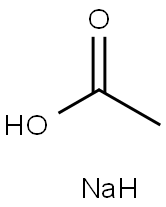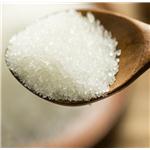Chemical Properties
Sodium diacetate has the odor of acetic acid. It is a molecular compound of sodium acetate and acetic acid. The pH of a 1 in 10 solution is between 4.5 and 5.0.
Chemical Properties
White crystals; acetic acid odor. Decom-
poses above 150C. Soluble in water; slightly soluble
in alcohol; insoluble in ether. Combustible.
Occurrence
Acetic acid or acetates are present in most plant and animal tissues in small, but detectable amounts.
Uses
Sodium Diacetate is a preservative, sequestrant, acidulant, and fla-
voring agent that is a molecular compound of sodium acetate and
acetic acid which yields acetic acid. it is a white crystalline powder
which is hygroscopic. it functions against mold and bacteria and is
used in bread. it is also termed sodium hydrogen diacetate.
Uses
Sodium acetate buffer solution has been used for the precipitation of DNA. It has also been used as a component of supporting electrolyte for electrochemical sensor.
Uses
Acetic acid in solid form; sequestrant; food preservative to inhibit molds and rope-forming bacteria in bread: Glabe, Food Ind. 14, no. 2, 46 (1942).
General Description
Sigma′s Sodium Acetate Buffer is a 3M solution prepared with 18 megaohm water and filter-sterilized.
Flammability and Explosibility
Non flammable
Agricultural Uses
Fungicide, Bactericide: Sodium diacetate is a fungicide and bactericide registered to control molds and bacteria, thereby preventing spoilage in stored grains. The pesticide is applied to hay as a dust or soluble concentrate (liquid spray) during the baling process. It is applied to silage as a fermentation "aid" to preserve the quality of field corn, alfalfa, sorghum, oats and grasses, stored in silos. Sodium diacetate is composed of acetic acid and sodium acetate. It dissociates to acetate, sodium and hydrogen ions, normal components of plants and animals, and of human foods. Acetates are formed in living organisms during the metabolism of food. Acetates and acetic acid have long been used in both human and animal foods, without significant adverse effects. Sodium diacetate is also used as an antimicrobial agent in baked goods and other foods, and in medicine and cosmetics manufacturing as a freshener, flavoring and pH regulator. Not listed for use in EU countries. 126-96-5. Registered for use in the U.S.
Trade name
CROP CURE®; DYKON®; GRAIN CURE®[C]; SENTRY SODIUM ACETATE®[C]
Safety Profile
When heated to decomposition it emits acrid smoke and irritating fumes
Synthesis
Prepared synthetically by reacting sodium carbonate with acetic acid. Special grades are produced by reacting anhydrous sodium acetate with acetic acid.




